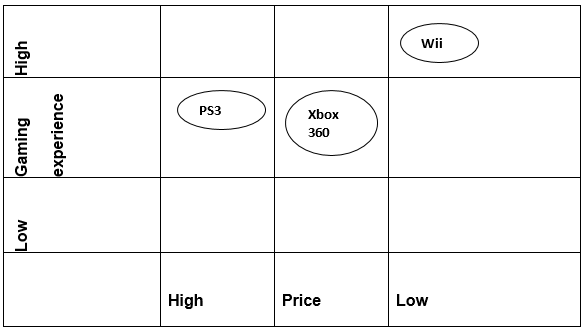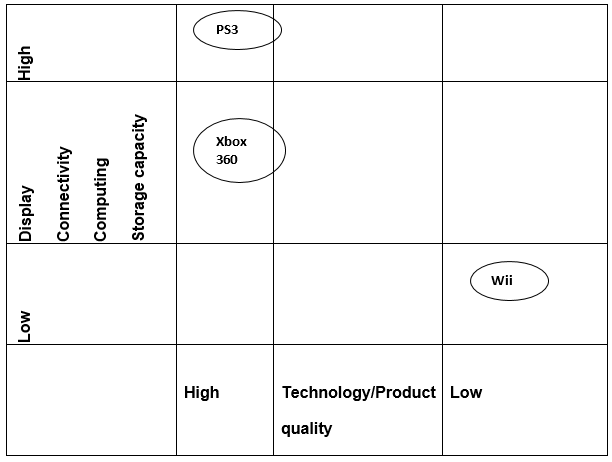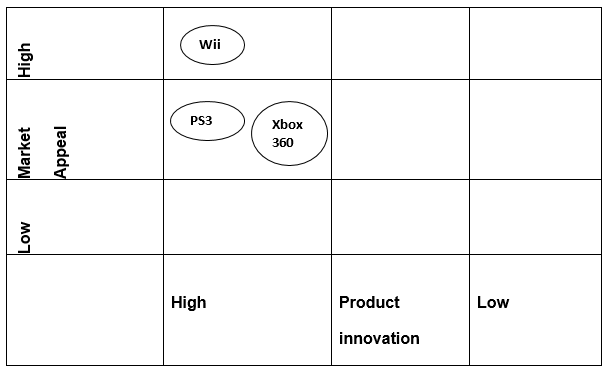Business Strategy
Question 1
Critically analyze the resources and competencies that a company in the video game consoles industry needs to possess to achieve a competitive advantage. Discuss and justify your arguments.
To gain a competitive advantage in the video game console segment, a company needs to adopt strategies that will enable its devices to stand out and therefore appeal to a larger portion of the market. Current market analysis indicates that casual gamers prefer video consoles that are innovative, affordable, and simple to use. On the other hand, hardcore gamers prefer devices that are technologically advanced with high definition displays and affordable (Gamble & Thompson 2010).
First-time players prefer simple innovative devices that are less intimidating and also affordable. Therefore a company that wishes to achieve a competitive advantage in the video console segment must be able to adopt strategies that will ensure that its devices appeal to all three market segments, and should also appeal to both young and mature players in all the three segments. An analysis of the third generation consoles produced by Microsoft, Nintendo and Sony, shows that both the Xbox 360 and PS3, were powerful ad technologically advanced compared to Nintendo’s Wii.
However, Nintendo sold more units of the Wii even though it had poor graphics and had only a standard CD drive while its rivals had powerful devices with high definition graphics and HD blue-ray drives. The Wii’s success can be attributed to its innovative controller, motion sensors, and affordability. This enabled it to appeal to first-time gamers, casual gamers, and hardcore gamers (Afuah 2011).
Question 2
Critically analyze the strengths and weaknesses of Sony in the video game consoles industry and identify any potential opportunities and threats for that company. Provide full support and justification for your arguments.
SWOT Analysis for Sony
Strengths
Sony has various strengths that enable it to command a considerable market share in the video gaming industry. First, Sony’s video game devices and games are innovative, technologically advanced, and therefore attractive to gamers of all age groups. The devices are also suitable for hardcore gamers, and casual gamers to a lesser extent. Secondly, the company has an innovative team that has build devices that can turntables in the market through the adoption of the latest technologies and enhance the gaming experience.
Lastly, the company has a long-standing market reputation for producing quality electronic products. For instance, Sony’s PlayStation 3 (PS3), has more advanced features compared to Microsoft’s Xbox 360, and Nintendo’s Wii that belonged to the same video game generation (Mulcaster 2009).
Weakness
Sony’s major weakness is producing video game consoles that are too expensive. For instance, the PS3 was launched at a retail price of between $499 and $599, a price that was too high for many video game lovers. At the same time, the company was making losses as the cost of producing one unit of PS3 was around $800 and it had hoped to make up for the loss through software sales. Sony also produces advanced video game systems that target mainly target hardcore gamers’ market segment. The PS3 was largely avoided by casual and first-time gamers due to its advanced features and high cost.
Opportunities
Sony’s first and second-generation video game consoles were wildly popular due to their innovative and advanced features that changed the gaming experience. The technology used then was not that expensive and so the devices were sold at fair prices. However, the PS3, though innovative and technologically superior, performed poorly when compared to other third-generation devices, particularly the Wii. Part of the problem was the global financial hardships that saw many families cutting their entertainment budgets. The company has an opportunity to build on its innovative advantage and develop video game systems that are affordable and able to satisfy the gaming needs of various categories of gamers.
Threats
A major threat to Sony comes from within the industry and notable from the other two major players, Nintendo and Microsoft. These companies, particularly Nintendo have already adopted innovative and cost-effective strategies that are already paying off. Another notable threat comes from the macro environment. Though the video gaming industry was not badly affected by the 2007-2008 recession, some ripple effects have been observed in the year 2008 (Jonson & Scholes 2008). The world economy has remained unbalanced due to several contributing factors such as rising oil prices. Many would-be customers are experiencing difficulties in meeting their basic needs and therefore they are likely to stay away from leisure activities such as video gaming.
The rising cost of fuel means that it will be more expensive to transport video game devices to retail outlets across the globe. The company has already registered a decline in sales volumes that can be linked to the recession, increased fuel costs, and the competitors (Mulcaster 2009).
Question 3
Prepare three different maps of strategic groups in the video game consoles industry, using different variables each time. Justify the selection of the variables, critically analyze the position of each competitor on the strategic group’s map and identify future opportunities for these companies based on their position



Figures 1, 2, and 3 show the different maps of strategic groups that outline the competition between the three main players in the video game industry. The 3rd generation video game consoles have been chosen to identify the main variables in the video console segment. According to the case study provided by John Gamble, the video game industry is mainly control by technology advancement/quality, innovation, and price variables (Gamble & Thompson 2010). The variables have been benchmarked on the needs of consumers. By using the 3rd generation devices in the console segment each of the three competitors can be located on the three different maps of strategic groups.
Nintendo has sold more units of the Wii due to its lower price, innovative controller, and advanced motion sensors that enhanced the gaming experience. Therefore, in as much as the Wii was less advanced in comparison to other devices in the same generation, it appealed to a bigger market due to the proper use of innovative and pricing strategies. According to the information provided by the maps of strategic groups, Nintendo is likely to forge ahead with its pricing and innovative strategies as they have worked well for it.
Microsoft’s Xbox 360 was an advanced third-generation console that came with a DVD optical drive, enhanced storage capacity, and excellent display. The device provided the quality desired by hardcore gamers but was a bit expensive compared to Nintendo’s Wii. The maps of strategic groups show that Microsoft used both quality and pricing strategies in the development of the Xbox 360. The company is likely to adopt an innovative strategy in its future video game consoles.
According to the maps of strategic groups, Sony seems to have mainly used the quality strategy in the development of the PS3. The video game console came with a blue ray optical drive, enhanced computing capacity among other specifications. The device was however too expensive, retailing between $499 and $599 (Jonson & Scholes 2008). Sony is likely to continue with its quality strategy but may additionally adopt the innovation strategy.
Question 4
Discuss the differences between the Planning and Emergent Schools of Strategy.
Discuss the importance of emergent strategy in fast-changing environments.
The strategic planning process often goes through several stages that aim to facilitate the achievement of an organization’s objectives. The typical planning process often includes the analysis of the external and internal environments; definition of the business and the mission; setting the objectives; formulation of strategies; and developing procedures for monitoring and controlling (Mulcaster 2009). On the other hand, an emergent strategy describes a pattern of action that forms over time in an organization that lacks a definite mission and goals or despite an organization’s missions and goals (Gamble & Thompson 2010).
Emergent strategies are effective in fast-changing environments as they are based on what works for an organization. By learning to do what works in actual practice organizations can maintain a purposeful direction even after deviating from their original strategies (Afuah 2011).
Question 5
Using relevant strategic analysis at the macro, industry, and micro levels, critically discuss the key strategic issues that Nintendo is currently facing.
The video gaming industry is dominated by Sony, Microsoft, and Nintendo. The three firms are fiercely competing to outdo each other. Their strategies mainly revolve around innovation, pricing, and adoption of the latest technologies. Nintendo has been the market leader for a long time but was outdone with the entry of Sony’s Playstation which produced more advanced gaming consoles and thus extending the gaming age bracket.
Since the entry of Sony, the companies have relied much on new technology to build their customer numbers. The Wii produced in 2006 and 2007 were completely sold off and the cumulative sales by 2008 were much higher compared to the other two major firms in the video gaming industry. However, overall company sales began to fall in the second quarter of 2008 (Mulcaster 2009). The decline was in both handheld devices such as the Nintendo DS and also in the console segment.
Analysts attributed the fall to decreased spending by households due to the ripple effects of global recession and rising fuel prices. The recession and rising fuel costs adversely affected the US and other developed nations that were the main markets for video gaming devices. Nintendo however decided to proceed on with its innovative strategies to consolidate its presence in the market.
Nintendo also over depends on third-party providers who account for approximately 90% of Nintendo’s video game releases. The company sometimes finds itself in conflict with these third party providers. For instance, between 1996 and 2005 the company had an issue with third-party providers for trying to cab video game-related violence. Many of the issues have since been sorted out but their potentiality remains a big threat to the company.
Question 6
Based on your preceding analysis in Question 2, specify three possible options that Nintendo should consider and justify the most suitable option using SAF criteria*.
SAF criteria
Nintendo can decide to pursue pricing, quality, or innovative strategy to enhance its competitive advantage.
Figure 4: pricing strategy.
Figure 5: Quality strategy.
Figure 6: Innovative strategy.
According to the analysis above, the best strategy that Nintendo should pursue is the innovative strategy as it may incorporate the pricing strategy.
Question 7
Using both SWOT and value chain analysis, critically discuss the core competencies that Nintendo possesses relative to its competitors.
SWOT Analysis
Strengths
Nintendo has various strengths that enable it to command a considerable market share in the video gaming industry. First, Nintendo’s video game devices and games are innovative and simple to use and are therefore attractive to the targeted market (Gamble & Thompson, 2010). Secondly, the company has a variety of video gaming products that are tailored to the gaming needs of people from diverse backgrounds and age groups. Most of the video gaming products are affordable and thus can be purchased by people from different economic classes and this has enabled the company to make huge profits even in times of financial hardships.
Weakness
Nintendo’s major weakness is the reliance on third-party providers.
Another weakness is the development of low-quality products. The Wii was installed with a 64MB DDR3 graphics card which was way too low compared to the Sony Playstation 3’s 256 MB DDR3 (Jonson & Scholes 2008).
Opportunities
The company has an opportunity to penetrate the casual video gamers segment with its innovative technologies and pricing strategy.
Threats
A major threat to Nintendo comes from within the industry and notable from the other two major players, Sony and Microsoft. Additionally, the world economy has remained unbalanced due to several contributing factors such as rising oil prices. The rising cost of fuel means that it will be more expensive to transport video game devices to retail outlets across the globe.
Already the company has registered a decline in sales volumes that can be linked to the recession, increased fuel costs, and the competitors (Afuah 2011).
Value chain analysis
Nintendo uses successful primary and secondary activities to stay ahead of the competition. The company manufactures quality products that are marketed effectively, for instance, by giving free games for every console purchased. The company also develops leading technological innovations that it protects for its benefit.
Question 8
The rate of technological innovation has a huge impact on all high-tech industries including Video Game Consoles. What recommendations would you make for Nintendo to cope with these changes in the future?
First, the company should adopt technologies that are less costly so as not to follow in Sony’s footsteps of producing each gaming device at an estimated $ 805 and selling it between $ 499 and $ 599 (Gamble & Thompson 2010). Secondly, the company should adopt technologies that will ensure that its products stand out just as it happened with the motion sensors and the innovative controller. Thirdly, the company should adopt technologies that match the needs of its consumers. For instance, casual gamers and first-time gamers will prefer simpler technologies compared to hardcore gamers.
The company should also adopt technologies that will show a progression in terms of quality. For instance, the use of better display properties in comparison to the previous systems to allow for a natural progression. Finally, the company should experiment with a variety of technologies available and select one that will work best for it.
References
Afuah, 2011. Strategic innovation: New Game Strategies for Competitive Advantage, University of Michigan, Michigan.
Gamble, J & Thompson, A 2010. Essentials of Strategic Management, University of Alabama, Alabama.
Jonson, G & Scholes, K 2008. Explorig Corporate Strategy, Prentice Hall, Essex.
Mulcaster, W 2009. ‘Three Strategic Frameworks’, Business Strategy Series , Vol.10 no.1, pp. 68-78.